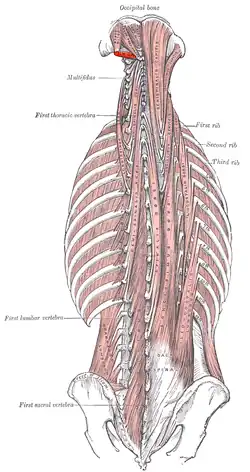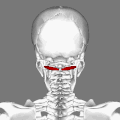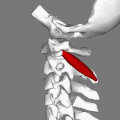Obliquus capitis inferior muscle
| Obliquus capitis inferior muscle | |
|---|---|
 Deep muscles of the back. (Obliq. infer. labeled at upper left.) | |
| Details | |
| Origin | spinous process of the axis |
| Insertion | lateral mass of atlas |
| Nerve | suboccipital nerve |
| Actions | Rotation of head and neck |
| Identifiers | |
| Latin | musculus obliquus capitis inferior |
| TA98 | A04.2.02.007 |
| TA2 | 2252 |
| FMA | 32528 |
| Anatomical terms of muscle | |
The obliquus capitis inferior muscle (/əˈblaɪkwəs ˈkæpɪtɪs/) is the larger of the two oblique muscles of the neck. It arises from the apex of the spinous process of the axis and passes laterally and slightly upward, to be inserted into the lower and back part of the transverse process of the atlas.
It lies deep to the semispinalis capitis and trapezius muscles.
The muscle is responsible for rotation of the head and first cervical vertebra (atlanto-axial joint).
It forms the lower boundary of the suboccipital triangle of the neck.
The naming of this muscle may be confusing, as it is the only capitis (L. "head") muscle that does NOT attach to the cranium.
Proprioception
The obliquus capitis inferior muscle, like the other suboccipital muscles, has an important role in proprioception. This muscle has a very high density of Golgi organs and muscle spindles which accounts for this. It is believed that proprioception may be the primary role of the inferior oblique (and indeed the other suboccipital muscles) allowing accurate positioning of the head on the neck.
Additional Images
 Position of obliquus capitis inferior muscle (shown in red).
Position of obliquus capitis inferior muscle (shown in red). Close up. Vertebral column, occipital bone and obliquus capitis inferior muscle. The muscle arises from the apex of the spinous process of the axis and insert into the lower and back part of the transverse process of the atlas.
Close up. Vertebral column, occipital bone and obliquus capitis inferior muscle. The muscle arises from the apex of the spinous process of the axis and insert into the lower and back part of the transverse process of the atlas. Obliquus capitis inferior's relationship to other suboccipital muscles.
Obliquus capitis inferior's relationship to other suboccipital muscles.
References
![]() This article incorporates text in the public domain from page 402 of the 20th edition of Gray's Anatomy (1918)
This article incorporates text in the public domain from page 402 of the 20th edition of Gray's Anatomy (1918)
External links
| Wikimedia Commons has media related to Obliquus capitis inferior muscles. |